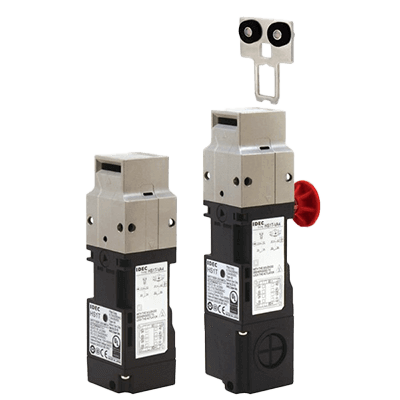What Is a Safety Door Switch?

Safety door switches are safety devices used to check the open/close status of safety fence doors and covers.
Many industrial machines are subject to powerful torque and pressure, and if a machine is activated while a door or cover is open, personal injury may occur. Therefore, they are often used as interlocking mechanisms to prevent equipment from starting when it is possible to enter a safety fence, or to stop equipment when a tobira is opened.
Various safety standards exist, such as ISO 14119, and standard products do not lose their function as safety sensors even in the event of a single failure. Selecting a safety door switch with a certification mark issued by a national or international certification organization will ensure a higher level of safety.
Uses of Safety Door Switches
Safety door switches are used for safety or device protection. The following are examples of applications for safety door switches:
1. Machine and Robot Control
Safety door switches are used to control the starting and stopping of machines and to ensure the safety of industrial robots. Most of the industrial machines used in manufacturing have safety barriers outside their range of motion, and in most cases, these are safety door switches. They are designed to automatically stop the machine when a door or cover is opened, preventing personal injury.
2. Security Applications
Safety switches may also be used for building security. Safety door switches are installed on the entrance and exit doors of buildings to prevent unauthorized entry by triggering an alarm when the door is unintentionally opened or closed.
3. Medical Equipment
Safety door switches are also used in medical equipment to protect machines and improve safety. e.g., MRI (magnetic resonance imaging) laboratories have doors with safety door switches that interrupt the examination when opened or closed. Safety door switches play an essential role in ensuring the safety of MRI examinations.
Principle of Safety Door Switches
A safety door switch consists of a sensor and a control circuit.
1. Sensor
Sensors are the components used to detect whether a door or cover is open or closed. They are shaped like microswitches, limit switches, or magnetic reed switches. They detect the open/close state of the door and feed back signals to the control circuit.
2. Control Circuit
The control circuit is an electrical circuit responsible for automatic stopping of the machine, etc. The control circuit is activated by feedback from the sensor and automatically stops the machine when the door is opened.
It is sometimes used in combination with an emergency stop switch. The emergency stop switch quickly stops the machine in the event of a hazard.
The combination of safety door switches and emergency stop switches provides greater protection for the operator and those around him.
Types of Safety Door Switches
Safety door switches can be classified into two main types: non-contact and electromagnetic lock.
1. Non-contact Type
Non-contact door switches are door switches with an internal reed switch. A dedicated actuator is attached to the switch, which detects the opening and closing of the door using a built-in magnet. Since it does not make contact with the door, it features few parts that are subject to mechanical wear.
While general reed switches can open and close contacts by using a magnet, safety door switches are designed to require the use of a dedicated actuator. This is to prevent malfunction of the reed switch.
2. Electromagnetic Lock Type
The electromagnetic lock type is a door switch with an electromagnetic lock function to lock the door. By selecting an electromagnetic lock type, it is possible to prevent accidental entry by locking the door. Generally, an interlock is provided to stop the equipment if the door is forcibly pried open when the door is locked.
Other Information on Safety Door Switches
Similar Safety Devices
Safety devices similar to safety door switches include light curtains and laser scanners. These devices detect intrusion by blocking visible and infrared light.
In recent years, light curtains and laser scanners have been increasingly used in manufacturing to save space and flexibly accommodate layout changes.